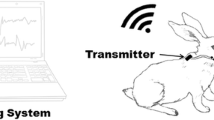Abstract
The aim of this study is to assess the neurophysiological abnormalities of type A botulin toxin-infiltrated human muscle, and their evolution over time. Seried cMAP measurements, 3 and 20 Hz repetitive nerve stimulation, EMG, SFEMG over 3 months from toxin injection. Our findings consist in lack of decrement with 3 Hz repetitive nerve stimulation and facilitation with 20 Hz repetitive nerve stimulation; progressive increasing of jitter; early appearance of fibrillations; small and short motor unit action potential in the first 3 weeks, followed by increasing of MUAP amplitude and duration, with polyphasic morphology. Although claimed as highly specific and sensible, neuromuscular junction facilitation is an inconstant finding in human botulism. Therefore, lack of neuromuscular junction facilitation cannot exclude a diagnosis of botulism. Our findings are compatible with a process of acute denervation followed by distal reinnervation, favored by terminal nerve sprouting.

Similar content being viewed by others
References
Simpson LL (2004) Identification of the major steps in botulinum toxin action. Annu Rev Pharmacol Toxicol 44(1):167–193. https://doi.org/10.1146/annurev.pharmtox.44.101802.121554
Horowitz BZ (2005) Botulinum toxin. Crit Care Clin 21(4):825–839. https://doi.org/10.1016/j.ccc.2005.06.008
Cherington M (2004) Botulism: update and review. Semin Neurol 24(2):155–163. https://doi.org/10.1055/s-2004-830901
Witoonpanich R, Vichayanrat E, Tantisiriwit K, Rattanasiri S, Ingsathit A (2009) Electrodiagnosis of botulism and clinico-electrophysiological correlation. Clin Neurophysiol 120(6):1135–1138. https://doi.org/10.1016/j.clinph.2009.01.019
Hamjian JA, Walker FA (1994) Serial neurophysiological studies of intramuscular botulinum-A toxin in humans. Muscle Nerve 17:13851392
Padua L, Aprile I, Lo Monaco M et al (1999) Neurophysiological assessment in the diagnosis of botulism: usefulness of single-fiber EMG. Muscle Nerve 22(10):1388–1392. https://doi.org/10.1002/(SICI)1097-4598(199910)22:10<1388::AID-MUS8>3.0.CO;2-3
Kimura J (1989) Electrodiagnosis in diseases of nerve and muscle: principles and practice (2nd ed). F. A. Davis, Philadelphia
Benatar M, Hammad M, Doss-Riney H (2006) Concentric-needle single-fiber electromyography for the diagnosis of myasthenia gravis. Muscle Nerve 34(2):163–168. https://doi.org/10.1002/mus.20568
Maselli RA, Bakshi N (2000) Botulism. Muscle Nerve 23(7):1137–1144. https://doi.org/10.1002/1097-4598(200007)23:7<1137::AID-MUS21>3.0.CO;2-7
Szuch E, Caress JB, Paudyal B, Brashear A, Cartwright MS, Strowd RE (2017 Mar 5) Head drop after botox: electrodiagnostic evaluation of iatrogenic botulinum toxicity. Clin Neurol Neurosurg 156:1–3. https://doi.org/10.1016/j.clineuro.2017.02.012
Cherington M (1982) Electrophysiologic methods as an aid in diagnosis of botulism: a review. Muscle Nerve 5(9S):S28–S29
Cornblath DR, Sladky JT, Sumner AJ (1983) Clinical electrophysiology of infantile botulism. Muscle Nerve 6(6):448–452. https://doi.org/10.1002/mus.880060609
Gutmann L, Bodensteiner J, Gutierrez A (1992) Electrodiagnosis of botulism. J Pediatr 121(5):835. https://doi.org/10.1016/S0022-3476(05)81936-5
Gutmann L, Pratt L (1976) Pathophysiologic aspects of human botulism. Arch Neurol 33(3):175–179. https://doi.org/10.1001/archneur.1976.00500030031006
Graf WD, Hays RM, Astley SJ, Mendelman PM (1992) Electrodiagnosis reliability in the diagnosis of infant botulism. J Pediatr 120(5):747–749. https://doi.org/10.1016/S0022-3476(05)80238-0
Shapiro BE, Soto O, Shafqat S, Blumenfeld H (1997) Adult botulism. Muscle Nerve 20(1):100–102. https://doi.org/10.1002/(SICI)1097-4598(199701)20:1<100::AID-MUS14>3.0.CO;2-8
Nogues MA, Rivero A, Poli M, Saadia D (1997) Adult botulism: difficulties in early electrodiagnostic studies. Muscle Nerve 20(10):1331–1332. https://doi.org/10.1002/(SICI)1097-4598(199710)20:10<1331::AID-MUS21>3.0.CO;2-4
Girlanda P, Dattola R, Messina C (1983) Single fibre EMG in 6 cases of botulism. Acta Neurol Scand 67(2):118–123. https://doi.org/10.1111/j.1600-0404.1983.tb04553.x
Schiller HH, Stalberg E (1978) Human botulism studied with single-fiber electromyography. Arch Neurol 35(6):346–349. https://doi.org/10.1001/archneur.1978.00500300020003
Mandler RN, Maselli RA (1996) Stimulated single-fiber electromyography in wound botulism. Muscle Nerve 19(9):1171–1173. https://doi.org/10.1002/(SICI)1097-4598(199609)19:9<1171::AID-MUS15>3.0.CO;2-Y
Holds JB, Alderson K, Fogg SG, Anderson RL (1990) Motor nerve sprouting in human orbicularis muscle after botulinum A injection. Invest Ophthalmol Vis Sci 31(5):964–967
Juzans P, Comella JX, Molgo J, Faille L, Angaut-Petit D (1996) Nerve terminal sprouting in botulinum type-A treated mouse levator auris longus muscle. Neuromuscul Disord 6(3):177–185. https://doi.org/10.1016/0960-8966(96)00041-7
De Paiva A, Meunier FA, Molgo J, Aoki KR, Dolly JO (1999) Functional repair of motor endplates after botulinum neurotoxin type A poisoning: biphasic switch of synaptic activity between nerve sprouts and their parent terminals. Proc Natl Acad Sci U S A 96(6):3200–3205. https://doi.org/10.1073/pnas.96.6.3200
English AW (2003) Cytokines, growth factors and sprouting at the neuromuscular junction. J Neurocytol 32(5-8):943–960. https://doi.org/10.1023/B:NEUR.0000020634.59639.cf
Harrison AR, Anderson BC, Thompson LV, McLoon LK (2007) Myofiber length and three-dimensional localization of NMJs in normal and botulinum toxin treated adult extraocular muscles. Invest Ophthalmol Vis Sci 48(8):3594–3601. https://doi.org/10.1167/iovs.06-1239
Wright MC, Cho WJ, Son YJ (2007) Distinct patterns of motor nerve terminal sprouting induced by ciliary neurotrophic factor vs botulinum toxin. J Comp Neurol 504(1):1–16. https://doi.org/10.1002/cne.21439
Author information
Authors and Affiliations
Corresponding author
Ethics declarations
This study was performed in accordance with the Helsinki Declaration. Written informed consent was obtained from all participating subjects. We confirm that we have read the Journal’s position on issues involved in ethical publication and affirm that this report is consistent with those guidelines.
Conflict of interest
The authors declare that they have no conflict of interest.
Rights and permissions
About this article
Cite this article
Lispi, L., Leonardi, L. & Petrucci, A. Longitudinal neurophysiological assessment of intramuscular type-A botulin toxin in healthy humans. Neurol Sci 39, 329–332 (2018). https://doi.org/10.1007/s10072-017-3191-3
Received:
Accepted:
Published:
Issue Date:
DOI: https://doi.org/10.1007/s10072-017-3191-3




